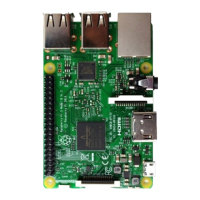14
15
16
17
18
19
20
21
22
23
24
25
26
27
28
29
30
31
Keypad keypad = Keypad( makeKeymap(keys), rowPins, colPins, ROWS, COLS );
int main( ){
printf("Program is starting ... \n");
if(wiringPiSetup() == -1){ //when initialize wiring failed, print message to screen
printf("setup wiringPi failed !");
return 1;
}
char key = 0;
keypad.setDebounceTime(50);
w hile(1){
key = keypad. getKey(); //get the state of keys
if (key){ //if a key is pressed, print out its key code
printf("You Pressed key : %c \n", key);
}
}
r eturn 1;
}
In this project code, we use two custom library file "Keypad.hpp" and "Key.hpp". They are located in the same
directory with program files "MatrixKeypad.cpp", "Keypad.cpp" and "Key.cpp". Library Keypad is transplanted
from the Arduino library Keypad. And this library file provides a method to read the keyboard. By using this
library, we can easily read the matrix keyboard.
First, define the information of the matrix keyboard used in this project: the number of rows and columns,
code of each key and GPIO pin connected to each column and each row. It is necessary to include the header
file "Keypad.hpp".
#include "Keypad.hpp"
#include <stdio.h>
const byte ROWS = 4; //four rows
const byte COLS = 4; //four columns
char keys[ROWS][COLS] = { //key code
{ '1', '2','3','A'},
{ '4', '5','6','B'},
{ '7', '8','9','C'},
{ '*', '0','#','D'}
};
byte rowPins[ ROWS] = {1, 4, 5, 6 }; //connect to the row pinouts of the keypad
byte colPins[ COLS] = {12,3, 2, 0 }; //connect to the column pinouts of the keypad
And then, based on the above information, instantiate a Keypad class object to operate the matrix keyboard.
Keypad keypad = Keypad( makeKeymap(keys), rowPins, colPins, ROWS, COLS );
Set the debounce time to 50ms, and this value can be set based on the actual use of the keyboard flexibly,
with default time 10ms.
keypad.setDebounceTime(50);

